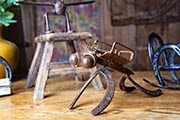 Culinary Art Immortalized: From table to wall
Culinary Art Immortalized: From table to wallBy Francine Butler, freelance writer
Culinary chefs understand the importance of presentation and how often have they heard that their food is almost a shame to eat. New York artist Hall Groat II has married his classical oil painting style with his appreciation of culinary art, specializing in desserts, by capturing them on canvas. He has been specializing in this genre of art for the last eight years and has avid collectors of this from all over the world.
Most collectors say they hang them in the kitchen and dining rooms where they evoke a warm welcoming feeling – making company feel at ease along with being aesthetically pleasing. They are often hung in groups.
San Francisco collector, Terasa Ng, states “I love the chocolate Truffles piece that I purchased; I hung the piece in my kitchen grouped with other chocolate desserts from other artists. The family came over for Thanksgiving and they love the pieces and it has inspired my family to display desserts in their kitchens.”
Another collector in Palm Beach states, “I hung two of the pastry paintings in my kitchen, one below the other. Not only do the colors in the paintings match the tones in my banquet room but I get the added bonus of having a couple of pastries without putting on weight.”
A prominent collector from Dubai, UAE during the summer of 2014 purchased two of Groat’s major dessert paintings, including lemon meringue pie and a banana split. The collector states, “Some twenty years ago we travelled a lot to Italy and my husband and kids would always eat a banana split while I would have an expresso. It became a joke that I had to watch the family eat goodies while I saved!”

 Many collectors have expressed that they like the colors and how the paintings become a lighthearted topic of conversation during dinner parties at their homes.
Many collectors have expressed that they like the colors and how the paintings become a lighthearted topic of conversation during dinner parties at their homes.Groat has created a couple hundred dessert paintings since 2006, ranging in size from tiny, six inch slices of cheese cake, all the way to gargantuan forty inch tall jelly-filled donuts. He has painted nearly every dessert one can imagine, from iconic banana splits and chocolate sundaes to popular culture brands, such as Tastykake cupcakes and Ben and Jerry’s ice cream cones. “Painting sweets early in the morning will curb your sugar addiction for the rest of the day” the artist claims. His studio drawers are filled with a variety of desserts that have been collected through the years that he uses as props to paint from. The sugar preserves them quite well.
The artist insists, “Both creating and looking at paintings is cathartic. When people think creatively and keep their minds busy, they often forget that they are hungry. So for your next dessert try taking a bite out of a mouth-watering oil painting of a raspberry tart, rather than being seduced by that fat filled chocolate pie at your local supermarket.
























